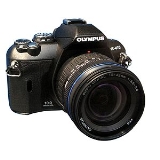
Olympus E-410
Encyclopedia
The Olympus E-410 is a 10 megapixel digital single-lens reflex (DSLR) camera
intended be the smallest and lightest DSLR on the market. Announced in March 2007 to succeed the E-400
(which was only marketed in Europe), it adds a live preview function and a new "Olympus TruePic III" processing chip that is claimed to provide better performance.
The E-410 body and lens mount conform to the Four Thirds System
standard, providing compatibility with other lenses for that system. (Four Thirds System lenses are smaller and lighter than lenses with similar specifications from other DSLR systems.)
Like the E-400, the E-410 is notable for its small size, omitting the hand grip and exploiting the smaller sensor of the Four Thirds System. It weighs only 375g and approaches manual focus film SLR sizes, reminiscent of the Olympus OM system
. It is accompanied by two new small zoom lenses, a 14–42 mm (28–84 mm 135 film format equivalent) f/3.5–5.6 standard zoom weighing 190g and a 40–150 mm (80–300 mm equivalent) f/4.0–5.6 long zoom weighing 220g.
The E-410 uses Olympus' patented Supersonic Wave Filter
dust reduction system
to shake dust from the sensor during startup and when requested by the user; this largely eliminates the problem of dust accumulation on the surface of the image sensor.
The camera was succeeded by the E-420. This newer camera's most notable enhancement over the E-410 is a contrast autofocusing system, for faster shooting in Live View mode.
Digital single-lens reflex camera
Most digital single-lens reflex cameras are digital cameras that use a mechanical mirror system and pentaprism to direct light from the lens to an optical viewfinder on the back of the camera....
intended be the smallest and lightest DSLR on the market. Announced in March 2007 to succeed the E-400
Olympus E-400
The Olympus E-400 is a digital single-lens reflex camera launched by Olympus on 14 September 2006, using the Four Thirds System lens mount standard....
(which was only marketed in Europe), it adds a live preview function and a new "Olympus TruePic III" processing chip that is claimed to provide better performance.
The E-410 body and lens mount conform to the Four Thirds System
Four Thirds System
The Four Thirds system is a standard created by Olympus and Kodak for digital single-lens reflex camera design and development.The system provides a standard that, with digital cameras and lenses available from multiple manufacturers, allows for the interchange of lenses and bodies from different...
standard, providing compatibility with other lenses for that system. (Four Thirds System lenses are smaller and lighter than lenses with similar specifications from other DSLR systems.)
Like the E-400, the E-410 is notable for its small size, omitting the hand grip and exploiting the smaller sensor of the Four Thirds System. It weighs only 375g and approaches manual focus film SLR sizes, reminiscent of the Olympus OM system
Olympus OM system
The Olympus OM System was a line of 35mm single-lens reflex cameras, lenses and accessories sold by Olympus between 1972 and 2002 ....
. It is accompanied by two new small zoom lenses, a 14–42 mm (28–84 mm 135 film format equivalent) f/3.5–5.6 standard zoom weighing 190g and a 40–150 mm (80–300 mm equivalent) f/4.0–5.6 long zoom weighing 220g.
The E-410 uses Olympus' patented Supersonic Wave Filter
Supersonic Wave Filter
The Supersonic Wave Filter is a dust reduction system developed by Olympus to overcome the negative effect of dust particles landing on the image sensor of digital SLRs. DSLRs are particularly vulnerable to this issue, since the interior of the camera is exposed during lens changes unlike other...
dust reduction system
Dust reduction system
A dust reduction system, or dust removal system, is a technology employed by several manufacturers of digital system cameras to solve the problem of dust particles adhering to the image sensor. Some systems remove or clean the sensor by vibrating at a very high frequency—between 100hertz and...
to shake dust from the sensor during startup and when requested by the user; this largely eliminates the problem of dust accumulation on the surface of the image sensor.
The camera was succeeded by the E-420. This newer camera's most notable enhancement over the E-410 is a contrast autofocusing system, for faster shooting in Live View mode.

